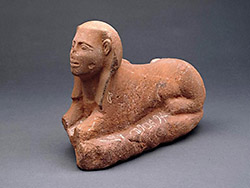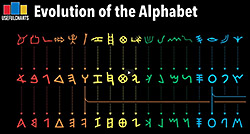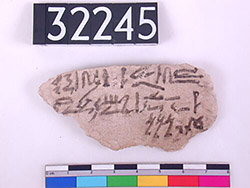Writing
This chapter covers the origins of different writing systems from archaic to modern, going back 5,400 years to the oldest written artifacts yet discovered, starting with cuneiform impressed into Mesopotamian clay tablets, hieroglyphs and hieratics written in ink on papyrus sheets in Egypt, and Chinese characters written on bamboo slips, also with ink. The roots of all the modern major writing systems in use today are explained and diagrammed. Also, types of media are illustrated.
TOPICS
• Archaic Writing Systems: Cuneiform; Hieroglyphics and Hieratics
• Other archaic systems
• Modern Writing Systems: Alphabetic systems
• Modern Writing Systems: Logosyllabic systems
• Other systems
• Media: Mesopotamia, Egypt, China
• Ink and colors
• Writing's Social Impact
• Cuneiform example
• Cuneiform evolution
• Hieroglyphics example
• Hieroglyph-Hieratic comparisons
• Modern writing systems map
• Alphabet writing systems timeline
• Latin alphabet evolution chart
• Examples of: Arabic, Cyrillic, Hebrew, Indic, Chinese-Japanese, Korean
• Clay tablet illustration
• Illustrations: Cylinder, brick, stamp seals
• Making papyrus sheets graphic
• Bamboo scroll illustration
• Ink and colors graphic
• Rosetta Stone
• Flood Tablet
• Papyrus - Heqanakht letter
People had been drawing pictures long before the earliest evidence of writing—the oldest cave paintings are from 64,000 years ago. It’s reasonable to assume, given the pictographic nature of the earliest writing systems, that this is how writing evolved, that simple pictures started being used to represent ideas.
A fully developed writing system, however, requires standardized characters and syntax—rules about how to arrange those characters—that all those using it agree on and understand. And such systems don’t appear to have emerged until after the first permanent human settlements evolved into cities, beginning around 6,000 or 7,000 years ago.
A writing system is different than a language, and most systems are used for multiple languages. For example, the Latin alphabet is used for many Western languages including English, Spanish and German, with minor modifications in each, such as accents or variations on letter forms. So there are many more languages than writing systems.
The oldest systems were logosyllabic, pictographic or logographic, in which each character represents, respectively, a syllable, a word, or a phrase. Many of the systems were combinations of these. The earliest versions of characters were essentially stylized drawings, which, as they evolved, tended to become more abstract to the point of no longer being recognizable. These systems also tended to have hundreds of characters and complicated rules for writing.
Alphabet systems, using far less characters, evolved a little later, and eventually became widely adopted across most of the world geographically. Writing systems today are largely alphabetic except in eastern Asia, where logosyllabic systems are used, principally in China and Japan.
Writing history
Oxford Companion to Archaeology. Edited by Brian M. Fagan, Oxford University Press 1996.
Alphabet: The History, Evolution, and Design of the Letters We Use Today. A. Haley, Watson-Guptill 1995.
The Alphabetic Labyrinth: The Letters in History and Imagination. J. Drucker, Thames & Hudson 1995.
The Blackwell Encyclopedia of Writing Systems. F. Coulmas, Blackwell: Oxford 1999.
The Cambridge Ancient History (3rd ed. 1970) pp. 43–44. I. E. S. Edwards, C. J. Gadd, N. G. L. Hammond, Cambridge University Press.
Letter Perfect: The Marvelous History of the Alphabet from A to Z. D. Sacks, Broadway Books 2003.
The Story of Writing. A. Robinson, London: Thames & Hudson 2007.
Writing Systems: A Linguistic Introduction. Geoffrey Sampson, Stanford University Press 2011.
The origins of abc. Editors, Archaelogy.org, May/June 2016.
The Evolution of Writing. James Wright, ed., International Encyclopedia of Social and Behavioral Sciences, Elsevier, 2014.
Cuneiform
Cuneiform. Irving L. Finkel, British Museum Press, 2001.
The World's Oldest Writing. Editors, Archaelogy.org, May/June 2016.
Sumerians. Joshua J. Mark, World History Encyclopedia, Oct. 9, 2019.
Sumerian cuneiform: Around The World From 80 Countries. Martha Fraundorf, Benton County Historical Society, Philomath, Oregon, June 8, 2017.
The Cuneiform Writing System in Ancient Mesopotamia: Emergence and Evolution. David Kleiner, NEH.gov, Nov. 13, 2009.
Cuneiform: 6 things you (probably) didn’t know about the world’s oldest writing system. Irving Finkel and Jonathan Taylor, History Extra, 2015.
The Epic of Gilgamesh. Scott Michael Rank ed., History on the Net, 2021.
Selections from the Cuneiform Tablets Collection: About the Collection. Library of Congress, 2017.
The Origins of Writing. Ira Spar, Department of Ancient Near Eastern Art, The Metropolitan Museum of Art, 2004.
Ah, Finally, Ancient Clay Tablets for Dessert. Jennifer A. Kingson, The New York Times, Nov. 14, 2016.
Evolution of cuneiform writing. Science Photo Library.
Seals and stamps
Written on Mud: Brick Inscriptions from Mesopotamia. H. Hameeuw, E. Gorris, J. Tavernier, Centre Assyriologicue Georges Dossin 2015.
Cylinder Seals in Ancient Mesopotamia - Their History and Significance. Joshua J. Mark, World History Encyclopedia, Dec. 2, 2015.
Sumerian Cylinder Seals. crystalinks.com.
Mesopotamian Cylinder Seals. Scott Michael Rank ed., History on the Net, 2021.
Cylinder Seal Depicting a Childbirth Scene. Jennie Myers, Research Associate, University of Chicago, 2010.
Egypt
Egyptian Grammar: Being an Introduction to the Study of Hieroglyphs pp. 438–548. 3rd Ed. A.H. Gardiner, Griffith Institute, Oxford 1957.
How to Read Egyptian Hieroglyphs: A Step-by-Step Guide to Teach Yourself. Mark Collier and Bill Manley, University of California Press, May 2003.
Ancient Egyptian Hieroglyphic Writing. Mark Millmore, discoveringegypt.com, 2021.
Ancient Egyptian scripts. Simon Ager, omniglot.com, 2021.
Something’s Fishy In The Palace Of Merneptah: Graffiti In Ancient Egypt. Jennifer Houser Wegner, Penn Museum, May 19, 2011.
The Hieratic Script. University College London 2002.
Papyrus and Parchment
Parchment-making. Michele Brown, Cornell University, April 3, 2015.
Papyrology Collection. University of Michigan library.
Papyrus in Ancient Egypt. Janice Kamrin, Department of Egyptian Art, The Metropolitan Museum of Art, March 2015.
Ink
Pigments and Inks Typically Used on Papyrus. Rachel Danzing, Brooklyn Museum, Sept. 22, 2010.
Composition and Properties of Egyptian Blue. Juraj Lipscher, ColourLex.
Realgar and Orpiment, Arsenic Sulfide Minerals. Hobart M. King, Geology.com.
Secrets of Ancient Egyptian Writing Revealed in 2,000-Year-Old Papyrus Scrolls. Kastalia Medrano, Newsweek, Dec. 3, 2017.
The History of Ink. James Morris, The Week, Dec. 5, 2014.
Egyptian Colour Palette (From c.3,000 BCE). Visual-Arts-Cork.com.
Ancient Egyptians likely made their inks with soot from ores, X-ray analysis reveals. Alexandru Micu, ZME Science, Nov. 13, 2017.
Proto-sinaitic
Alphabets, Texts and Artifacts in the Ancient Near East. Various authors. Van Dieren Editeur. 2016.
The Alphabet: Its Rise and Development from the Sinai Inscriptions. Martin Sprengling. U. of Chicago Press, 1931.
Proto-Sinaitic – Progenitor of the Alphabet. Frank Simons. University of Birmingham, 2011.
Colorful Chart Reveals Evolution of English Alphabet From Egyptian Hieroglyphics. Emma Taggart, mymodernmet.com, Jan. 25, 2019.
About the Proto-Semitic alphabet. earlysemitic.weebly.com.
The Alphabet’s Brilliant Conquest. Daniel Kenis, medium.com, May 26, 2016.
Greece
Linear B Script. Cristian Violatti, World History Encyclopedia, Jan. 26, 2015.
Polis. Mark Cartwright, World History Encyclopedia, June 6, 2013.
Greek History. Thomas Sakoulas, Ancient-Greece.org, SUNY Oneonta.
Greece Timeline. Thomas Sakoulas, Ancient-Greece.org, SUNY Oneonta.
The Archaic Cretan Greek Alphabet. Ray Brown, carolandray.plus.com, July 30, 2018.
History of the Greek Language. greek-language.com, 2020.
9 Greek Cities Among Europe’s 15 Oldest. Katerina Papathanasiou, greekreporter.com, Oct. 22, 2015.
Ancient Tablet Found: Oldest Readable Writing in Europe. Ker Than, National Geographic News, April 1, 2011.
Greek (ελληνικά). omniglot.com.
Differences Between Hellenistic and Hellenic Greek Civilization. Tiffany R. Isselhardt, owlcation.com March 12, 2021.
Rosetta Stone
Object: The Rosetta Stone. The British Museum.
What Is the Rosetta Stone? Elizabeth Nix, history.com, Nov. 5, 2019.
Latin alphabet
The Alphabet’s Brilliant Conquest. Daniel Kenis, medium.com, May 26, 2016.
Writing and Pronouncing Latin.PDF. latinata.com.
Latin alphabet. Simon Ager, omniglot.com.
Writing systems
In the Beginning: A Short History of the Hebrew Language. Joel Hoffman, NYU Press, 2004
Chinese Writing. Emily Mark, World History Encyclopedia, April 7, 2016.
The Difference between Japanese and Chinese Characters. Arc Communications.
Ethiopic alphabet. britannica.com.
Japanese language. Masayoshi Shibatani, Professor of Linguistics, Kobe University, Japan. britannica.com.
The Korean Alphabet: An Introduction. korean-arts.com.
An Overview of the History of The Japanese Language. Daniel J. Vogler, byu.edu.
Origins and Characteristics of the Arabic Alphabet. metmuseum.org.
Earliest New World Writing Discovered. Christopher Joyce, npr.org, Sept. 15, 2006.
Writing May Be Oldest in Western Hemisphere. John Noble Wilford New York Times, Sept. 15, 2006.
Armenian (Հայերէն). omniglot.com.
Devanāgarī (देवनागरी लिपि). omniglot.com.
Ge’ez script. (Ethiopic). omniglot.com.
Infographic: History of the Arabic Alphabet. Qatar Foundation Intl., Oct 5, 2018.
Roots of Mesoamerican Writing. Erik Stokstad, Science Magazine, Dec. 5, 2002.
The Yellow River’s Role in China’s History. Kallie Szczepanski, thoughtco.com, July 28, 2019.
List of writing systems. wikipedia.org.
Lesson 1: The Korean Alphabet is 24 Letters. yeskorean.com, July 1, 2010.
NOTE: Weblinks were current and active at the time of the last update to the site, but may have since become unavailable or outdated. If you encounter a dead link, please notify me at phil.loubere@mtsu.edu. Thanks.
Last update: April 2021
Content related to this chapter’s topics will be periodically posted here.
Alphabet
Alphabets evolved out of earlier logosyllabic writing systems such as Egyptian hieroglyphics. The Roman alphabet can be traced back to the earliest known alphabet system, the Proto-Sinaitic alphabet from about 4,000 years ago in what was then Canaan or Phoenicia, in the Sinai Peninsula region north of Egypt. Present-day Greek, Cyrillic, Hebrew and Arabic alphabets also evolved from the same source.

Who Invented the Alphabet? A new hypothesis suggests that the earliest alphabet was invented by people who couldn't read. Lydia Wilson, Smithsonian Magazine, Jan-Feb 2021.

The Latin Alphabet. This video shows the historical evolution of the Latin alphabet. Matt Baker, usefulcharts.com.

Language Tree. Writing systems are not the same as languages. Many writing systems are used for several languages; for example, the Latin alphabet is used for most Western languages including English, Spanish, German, etc. But there is some common history. This illustration shows the evolution of languages. Notice how the languages that use the Roman alphabet are all together in the right branch of the tree.
mymodernmet.com/comic-artist-illustrated-linguistic-tree/
Cuneiform
Character shapes are often the result of the instruments used to create them, and that is most obvious with cuneiform, whose wedge-shaped marks come from pressing the tips of sharpened reeds into wet clay tablets. This writing system is the oldest that we know of, with artifacts dating back as far as 5,400 years ago, and was in use the longest of any in human history, about 3,500 years.

Cuneiform. Irving Finkel, British Museum, May 1, 2015.
This book discusses the history of the writing system that was used for numerous languages in the ancient world.
Seals and stamps
The earliest known devices for reproducing images and text were cylinder seals, which were rolled on clay tablets, and various stamps and seals, including brick seals, which were used to stamp information into bricks prior to their use in construction. The earliest of these date from 6 thousand years ago.

Cylinder Seals in Ancient Mesopotamia - Their History and Significance. Joshua J. Mark, World History Encyclopedia, Dec. 2, 2015.
This article explains what cylinder seals are and what they were used for.
Egypt
Common everyday writing in Egypt was done in hieratics, which was a kind of shorthand version of hieroglyphics. It eventually evolved into a somewhat simpler system called demotics. Hieroglyphics and hieratics were in use for nearly as long as cuneiform, about 3,300 years, from the unification of Egypt in 3,100 BCE until the first century CE.

The Hieratic Script. University College London 2002.

'Lost golden city' found in Egypt reveals lives of ancient pharaohs. BBC News, April 9, 2021.
Last update: September 2021


